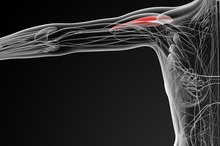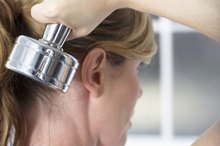How to Relieve Mid Back Pain
Mid-back pain typically arises due to a muscle strain caused by poor posture, lifting an object improperly, or sudden twisting, often during sports such as basketball, golf or softball. You can normally alleviate the pain caused by minor strains quickly if you follow a conservative treatment plan. Such a plan should include a period of rest followed by exercises to restore your range of motion and strength, according to Dr. William Prentice, a physical therapist and author of the textbook “Essentials of Athletic Injury Management.”
Flexibility Exercises
Grasp a bar with your palms facing forward and hang for 5 to 10 seconds, allowing gravity to stretch your spine. Rest for a minute and then repeat the stretch with an underhanded grip.
How to Increase Flexibility in My Big Toes
Learn More
Extend your arms behind your back and clasp your hands together. Raise your arms upward until you feel a gentle stretch in the middle of your back and front of your shoulders. Hold for 10 seconds.
Stand upright with your feet about shoulder-width apart. Place your hands behind your head with your elbows pointed outward, away from your ears. Twist to the left 90 degrees, so your left elbow points backward. Hold for 10 seconds and then repeat in the opposite direction.
- Grasp a bar with your palms facing forward and hang for 5 to 10 seconds, allowing gravity to stretch your spine.
Strengthening Exercises
How to Correct Pulled Forward Shoulders
Learn More
Lie on your back with your legs extended and elevated so your lower legs lie on top of a stability ball. Lift your hips to create a straight line from your knees to your shoulders. Keep the back of your shoulders and your head on the floor. Hold for 10 seconds.
Sit or stand under a pulldown bar attached to a weight stack. Extend your arms upward and grasp the bar wider than shoulder-width with your palms facing forward. Abduct your arms, moving your elbows down and toward your ribs, and flex your arms to pull the bar behind your head until it touches the base of your neck. Slowly let the bar back up and repeat. Perform 8 to 12 reps.
Sit with your spine erect, knees bent slightly and heels on the floor. Hold a weighted object, such as a medicine ball, in front of your abdomen. Rotate with the object as far as you can to the left, then to the right. Continue alternating sides for 20 total reps.
Lie with your upper back on top of a stability ball, knees bent to 90 degrees, and feet flat on the floor. Extend your hands above your chest. Twist to the left, followed by the right. Continue twisting back and forth for 12 total reps. Hold a weighted object in your hands to increase the difficulty.
Tips
Discontinue any activities that may have contributed to your mid-back pain. Do not perform any additional activities that might aggravate your injury. Use ice and heat treatments to help manage your pain.
Visit your doctor if your pain does not subside after several days of rest. Discuss your symptoms and possible causes so she can organize a treatment plan. Take any medications she recommends or prescribes, such as anti-inflammatory drugs or muscle relaxants, as directed.
Perform the flexibility exercises every day and the strengthening exercises several times per week.
Warnings
Back pain can result from conditions such as herniated discs, spinal stenosis and degenerative disc disease, according to Spine-Health.com. See your doctor if your pain does not go away after two or three months to check for one of these conditions.
- Lie on your back with your legs extended and elevated so your lower legs lie on top of a stability ball.
- Lie with your upper back on top of a stability ball, knees bent to 90 degrees, and feet flat on the floor.
Related Articles
References
- MayoClinic.com: Back Pain
- "Essentials of Athletic Injury Management (Seventh Edition)"; William E. Prentice, PhD., A.T.C., P.T.; 2008
- "Relax Into Stretch"; Pavel Tsatsouline; 2001
- American Council on Exercise: Back Exercises
- American Council on Exercise: Seated Medicine Ball Trunk Rotations
- Zhang H, Tong TK, Qiu W, et al. Comparable Effects of High-Intensity Interval Training and Prolonged Continuous Exercise Training on Abdominal Visceral Fat Reduction in Obese Young Women. J Diabetes Res. 2017;2017:5071740. doi:10.1155/2017/5071740
- Park HK, Jung MK, Park E, et al. The effect of warm-ups with stretching on the isokinetic moments of collegiate men. J Exerc Rehabil. 2018;14(1):78-82.
- Calatayud J, Borreani S, Colado JC, et al. Muscle Activation during Push-Ups with Different Suspension Training Systems. J Sports Sci Med. 2014;13(3):502-10.
- Bharti N, Hrubeniuk T, Mayo A, Sénéchal M, Bouchard DR. Resistance Training Contribute to the Aerobic Components of an Exercise Session in Adults but not as Much in Older Adults. Int J Exerc Sci. 2017;10(3):406-416.
- Lorenzetti S, Ostermann M, Zeidler F, et al. How to squat? Effects of various stance widths, foot placement angles and level of experience on knee, hip and trunk motion and loading. BMC Sports Sci Med Rehabil. 2018;10:14.
Writer Bio
Matthew Schirm has worked in the sports-performance field since 1998. He has professional experience as a college baseball coach and weight-training instructor. He earned a Master of Science in human movement from A.T. Still University in 2009.








